|
| |
Back to
airliners
 |
The Aviation Traders Carvair was a bold
venture by the Aviation Traders Company at Southend to create a dedicated car
ferry. The company took second hand Douglas DC4s, and reworked them
with a new, vast nose with sideways opening front door and the
cockpit relocated above. A DC7 tail was added to preserve lateral
stability. It could take five cars plus 25 passengers at 195mph for
up to 1,700 miles. 21 were made, and saw service in many countries.
James Bond took his Aston Martin on one in the film `Goldfinger'. It
first flew in June 1961. Power was from four 1,450hp Pratt & Whitney
Twin Wasp radials. Gross weight was 73,800lb. Length, 102 feet 7
inches; wing span, 117 feet 6 inches. This example (G-AOFW) was pictured at Southend
in the mid 1970s after competition from seaborne ferries had
rendered the Carvair uneconomic. |

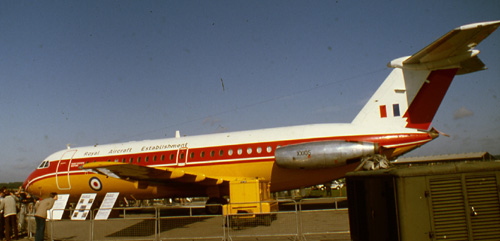 |
The BAC 1-11 was originally designed by the
Hunting Aircraft Company in the 1950s as a 32 seat short range
airliner. When Hunting was absorbed into the British Aircraft
Corporation in 1960, the design was expanded to be a 79 seater and
renamed the BAC one-eleven. It was intended as a replacement
for the Vickers Viscount (see below). First flight was in August
1963. The prototype crashed during testing (from the `deep stall'
phenomenon afflicting T-tail jet designs), but modifications to the
elevator and wing leading edge overcame the problem. Many versions followed. The
airframe was very flexible and well suited to `stretching' the
fuselage; the longest version, the series 500, seated 109. Over 240
were built between 1963 until production finally ceased almost 20
years later, including several under license in Romania. It was widely exported.
Power was by two Rolls-Royce Spey turbojets,
ranging between 10,410 and 12,000 lb thrust each. Wing span ranged
from 88 feet 6 inches to 93 feet 6 inches; length from 93 feet 6
inches to 107 feet. Cruising speed was between 500 and 540mph, and
range between 1,050 and 2,100 miles, depending on version.
The biggest problem with the engines was
noise. The top one, seen at Gatwick in the 1970s, had hush-kits fitted
in an attempt to alleviate the problem. Later, some were re-engined
with the quieter Rolls-Royce Tay engine. The lower one is an example
used for research purposes by the Royal Aircraft Establishment, at
Farnborough in September 1980. |
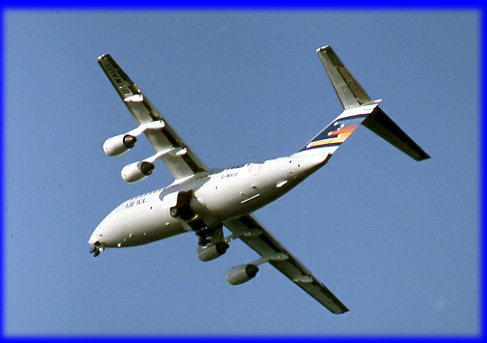 |
The British Aerospace 146 was conceived in
the mid 1970s as a modern replacement for the BAC 1-11. Britain's
severe economic problems, a legacy of misguided socialist economic
policies, delayed the project so that it did not fly until September 1981.
It is unusual for a regional jet in having four
engines (Avco Lycoming ALF502 turbofans of 6,790 lb thrust each, on
the series 100: later versions, known as the RJ series, had the
Allied Signal LF507 of 7,000 lb thrust): a good selling point for safety and quietness, but not for
operating cost. It sold slowly until the impact of deregulation in
the mid 1980s saw a surge of orders for new short range point to
point services, and led to high sales to airlines like Lufthansa,
Swissair and Sabena. Between 70 and 116 passengers can be carried,
depending on version and seating layout. Weight ranged from 84,500
to 101,500lb. Typical cruising speed is 400mph, and range 1,900
miles. Length is 85 feet 10 inches, wing span is 86 feet 5 inches
(series 100). By the time production ended in 2002, 378 of all
versions had been built. This example was
seen at Farnborough in September 1984, destined for Ansett of
Australia. |
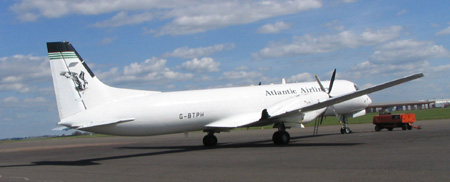 |
The BAe ATP was a bold attempt to reinvent
the HS748 for the 1980s commuter airliner market. Several years
before its first flight, a journalist asked the managing director of
British Aerospace when it would fly. Taking an educated guess, he
replied `6th of August 1886'. Suspicious of this precise answer, the
journalist jokingly asked, `what time?' `Twelve O'clock', came the
deadpan reply. Actually, it was 20 minutes late! Unfortunately, it
was not a commercial success. It was over-engineered to compete with
simpler established rivals such as the ATR range. Only 67 were
built. Its two 2,650hp Pratt & Whitney PW126A turboprops give it a
cruising speed of 300mph and range of 920 miles.
This one has been converted to a freighter, and was at Coventry in April 2006. |
 |
The Bristol 170 Freighter was one of the
first British transport aircraft to emerge after the second world
war. It was an extremely simple, rugged design, optimised for
operation from rough jungle airstrips. The raised flight deck meant
that the cargo hold was free from any obstructions. It was popular
with cargo operators and with specialised car ferries, where two
cars and their occupants could be carried across the English
channel. Unfortunately the construction was somewhat too simple: in
very cold weather the metal contracted, and the rain got in.
Passengers often had to wear raincoats. But it was effective, with
214 being built. It was sometimes affectionately known as the `Biffo',
derived from its name but recalling the cartoon bear in the Beano! This example was
pictured at Coventry in May 1986. |
|
|
The Bristol Britannia was known as the
`Whispering Giant' because of the characteristic sound of its
Proteus engines. Unfortunately they also proved rather unreliable,
which is the main reason only 85 were built. The Britannia 312 could
take up to 99 people for 5,760 miles at 335mph - among the best
performance of any major turboprop airliners.
Britannias served in the Royal Air Force as well;
this example, belonging to the Aircraft & Armament Experimental
Establishment, was seen at the Greenham Common air show in July
1983. |

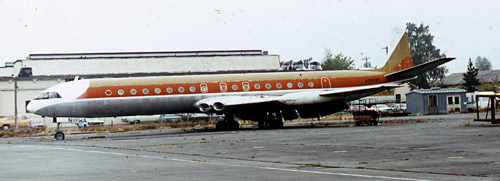
(for the ultimate Comet development, the
Nimrod, see under miscellaneous military
aircraft) |
The De Havilland DH106 Comet was the world's
first jet airliner, as well as being one of the sleekest ever built.
It first flew in July 1949, five years ahead of the American Boeing
707. Burying the engines in the wing roots reduced drag and made it
a very efficient airframe. Unfortunately, a series of accidents
marred its reputation. They were traced to a fatigue failure at the
corner of a rectangular dielectric panel; this led to a much deeper
understanding of the behaviour of metal structures undergoing
substantial changes in pressure. The fault was fixed, and the
improved Comet 4 was virtually flawless, but the reputation had
suffered: only 108 were built. The top one,
a comet 4C, was operated by the Royal Aircraft Establishment with a
modified tail for aerodynamic trials. It was pictured at Bournemouth
(Hurn) in August 1984. The lower one is also a 4C but with the
normal tail (N888WA), at Paine in September 1981. |
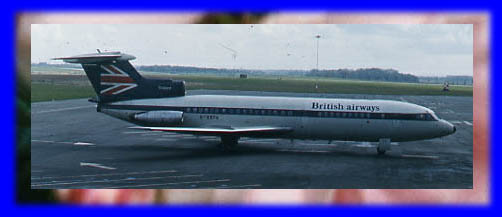
 |
The De Havilland DH121 Trident was one of
many British airliners which was produced to the specification of
British European Airways (BEA) or its intercontinental counterpart,
British Overseas Airways Corporation (BOAC). Being designed for one
customer inevitably limited its appeal and was a major factor in
there being only about 100 built. It carried 110 people, or in its
later versions up to 180. It introduced pioneering technology for
automatic landing, enabling it to operate safely in very poor
weather (so long as the airport was equipped with the right
facilities). The Rolls-Royce Spey engines were incredibly noisy, so
the aircraft was unable to survive the clampdown on aircraft noise
in the 1980s, and was replaced by the Boeing 737.
Top picture: a Trident 1, G-ARPK, was taken at
Newcastle in April 1976. Note the old BEA colour scheme but the name
`British Airways' roughly taped over - BEA and BOAC had just merged,
and the aircraft not yet fully painted. Lower picture: Trident 1E of
Northeast airlines, just after their takeover by British Airways,
also at Newcastle in August 1974. |
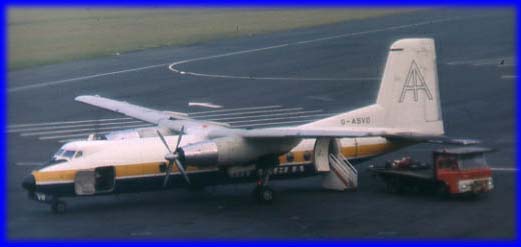 |
The Handley Page Herald originated with
Handley Page's acquisition of the transport division of the Miles
aircraft company after its bankruptcy in 1948. The Herald was a much
enlarged version of the Miles Marathon, seating 56 people, with a
single slab tail, and two Rolls-Royce Dart turboprop engines
replacing the four piston engines of the earlier design. Despite
very similar performance it was unsuccessful in competition with the
similar Fokker Friendship, and
production ended after only 50 had been built.
This Herald, operated by Air Anglia, was
photographed at Newcastle in November 1975. |
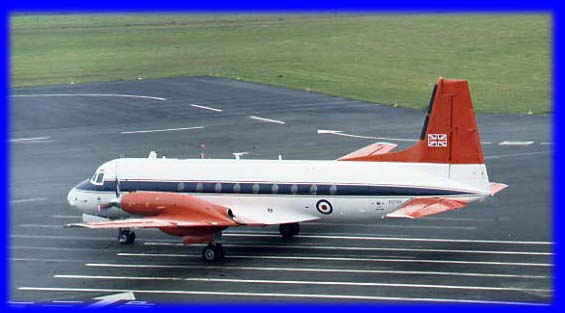 |
The Hawker Siddeley (originally Avro) 748,
like the Herald, was built to take advantage of the excellent
Rolls-Royce Dart turboprop engine. It carried up to 60 passengers.
First flying in 1960, it remained in production for around 15 years
in Manchester, England and under license in India. It is a very
robust and reliable machine, ideally suited to intensive operation
over short ranges. 200 were built and saw service in every continent
of the world.
This one was used by the Queen's Flight as one
of Her Majesty's official aircraft, and was seen at Newcastle in the
late 1970s. |
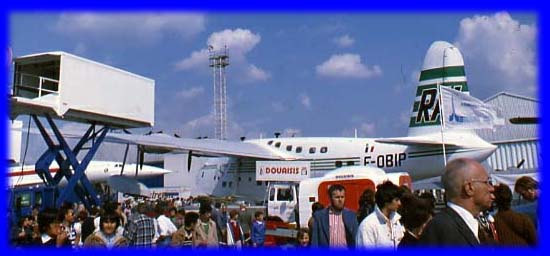 |
This rather cluttered photograph is the best
I could get of Short Sandringham F-OBIP at Le Bourget. The
Sandringham was the penultimate in a line of huge, luxurious flying
boats built by Shorts from 1936 (S23 Empire) to 1949 (S45 Solent).
They had a variety of configurations, ranging from 45 passengers
(with a cocktail bar on the upper deck!) to only 16 passengers in
all sleeper configuration. Not surprisingly they were uneconomic
compared with the mass-transit Boeing 707s, and gradually faded from
use until only a few remain. |
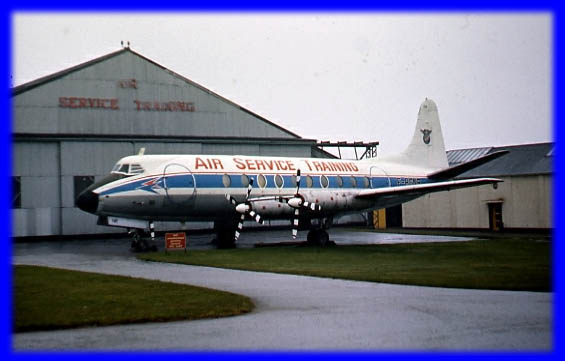
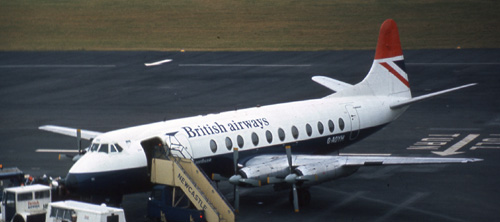 |
The Vickers Viscount, apart from being the
world's first turboprop airliner, is arguably the most successful
British airliner ever. 459 were built and saw service worldwide. It
first flew in July 1948, and represented a huge step change
improvement over its contemporary piston engined competitors. The
final version seated up to 75 people. A particularly
passenger-pleasing feature was the massive oval windows, which
afforded a superb view. Even the high-pitched whirring note of the
engines sounded friendly. Viscounts remained in service until the
1990s, by which time their four Rolls-Royce Dart engines had become
too expensive to operate compared with more modern twin turboprop
competitors. Top: This French-operated
Viscount (F-BGNF) was acquired by Air Service Training and was seen
on a gloomy day at Perth in April 1978.
Bottom: Viscount 806 operated by British
Airways, at Newcastle in May 1976. |
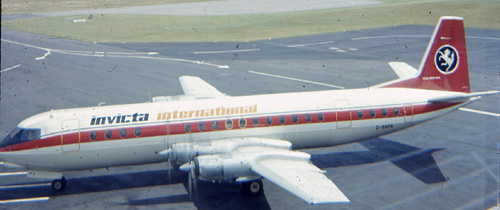
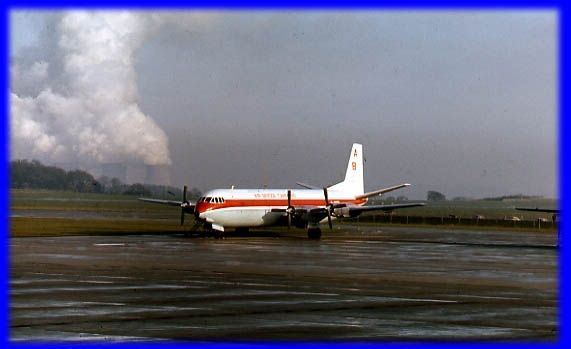 |
The Vickers Vanguard, in sharp contrast to
the Viscount, was another victim of the UK's misguided policy of
building aircraft which were optimised for the then state-owned
airlines. This meant that no-one else wanted it; everyone else who
might have bought a Vanguard preferred the American Lockheed
Electra. Only 43 were built, the first flying in January 1959. They
had big, growling Rolls-Royce Tune turboprops, and could carry 132
people over 2,000 miles at over 400 miles per hour.
Top picture: Vanguard operated by Invicta
International, Newcastle, July 1975.
After replacement on passenger services, many
were converted to freighters. They were very suitable for this role,
having an unusual `double bubble' fuselage design. The one in the
lower picture, G-APES,
was bought by freight operator Air Bridge Carriers and was seen at
East Midlands in December 1976. |
|
|
Despite being designed for BOAC (British
Overseas Airways Corporation), the Vickers VC10 was actually a
rather good aircraft. Carrying up to 174 people over a range of
5,000 miles, performance was very comparable to the competing Boeing
707. Passenger comfort was better, because the rear-mounted
Rolls-Royce Conway engines were mounted at the back to give a very
quiet cabin. Unfortunaely it was also more expensive for operators,
which limited its appeal. Of only 56 built, most were operated by
BOAC. The layout was adopted by Russian designer Ilyushin for his
Il62. Some
were used as troop transports by the Royal Air Force, including the
top
one (XR806) seen at Newcastle in 1976. Others have been converted to
a dual role as transports and in-flight refuelling tankers,
including XR810 seen at Fairford in July 2005. |





|